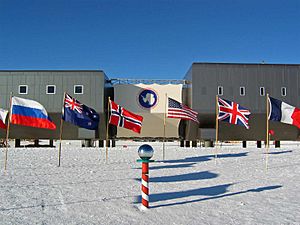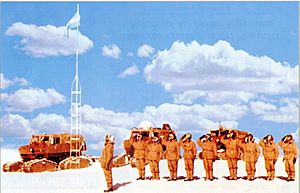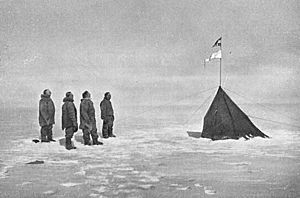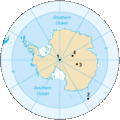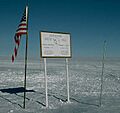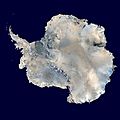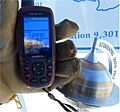South Pole facts for kids
The South Pole, also known as the Geographic South Pole, is the southernmost point on Earth. It's one of the two spots where Earth's spinning axis meets its surface. The other spot is the North Pole. The South Pole is located on the continent of Antarctica.
It is home to the United States Amundsen–Scott South Pole Station. This station was built in 1956 and has had people living there ever since. The Geographic South Pole is different from the South Magnetic Pole, which is where a compass points due to Earth's magnetic field. The South Pole is right in the middle of the Southern Hemisphere.
Contents
Geography of the South Pole
The Geographic South Pole is the southern point where Earth's spinning axis touches its surface. Earth's axis actually wobbles a tiny bit, but this definition works for most uses.
The South Pole's location is usually given as 90°S. Its longitude doesn't really matter because all lines of longitude meet there. If a longitude is needed, it's often given as 0°. At the South Pole, every direction you look is north! So, directions are given based on "grid north," which points north along the Prime Meridian.
The Geographic South Pole is currently on Antarctica. It sits on a flat, icy, and windy plateau about 2,835 meters (9,301 feet) above sea level. It's about 1,300 kilometers (808 miles) from the nearest open sea. The ice at the Pole is about 2,700 meters (8,858 feet) thick. This means the land underneath the ice is actually close to sea level.
The huge ice sheet is always moving, about 10 meters (33 feet) each year. Because of this, the South Pole station and other things built there slowly move away from the exact geographic pole.
The Geographic South Pole is marked by a stake in the ice and a small sign. These are moved every year on New Year's Day to keep up with the ice's movement. The sign shows the dates when Roald Amundsen and Robert F. Scott reached the Pole.
Ceremonial South Pole
The Ceremonial South Pole is a special area at the Amundsen–Scott South Pole Station. It's used for taking photos. It's a few meters away from the actual Geographic South Pole. It has a shiny metal sphere on a short pole, surrounded by the flags of the countries that first signed the Antarctic Treaty.
Historic Monuments at the Pole
Amundsen's Tent
Roald Amundsen and his team put up this tent on December 14, 1911. It is now buried under snow and ice near the Pole. It's been named a Historic Site or Monument (HSM 80). In 2010, experts thought it was about 1.8 to 2.5 kilometers (1.1 to 1.5 miles) from the Pole, buried 17 meters (56 feet) deep.
Argentine Flagpole
An Argentine flagpole was put up at the South Pole in December 1965 by the First Argentine Overland Polar Expedition. This flagpole has also been named a Historic Site or Monument (HSM 1).
Exploration of the South Pole
Early Discoveries (Before 1900)
In 1820, several groups said they were the first to see Antarctica. The Russian expedition led by Fabian Gottlieb von Bellingshausen and Mikhail Lazarev was likely the first. The first person to step on the ice was probably American captain John Davis a year later.
People didn't really understand the shape of Antarctica's coastline until the mid-to-late 1800s. American naval officer Charles Wilkes correctly said that Antarctica was a new continent in 1839–40. James Clark Ross hoped to sail all the way to the South Pole in 1839–1843, but he didn't succeed.
First Journeys to the Pole (1900–1950)
British explorer Robert Falcon Scott tried to find a path to the South Pole during his Discovery Expedition (1901–1904). On December 31, 1902, Scott, Ernest Shackleton, and Edward Wilson reached 82°16′ S, going as far south as anyone before. Shackleton later tried again with his Nimrod Expedition. On January 9, 1909, he and three friends got within 112 miles (180 km) of the Pole before having to turn back.
The first people to reach the Geographic South Pole were the Norwegian explorer Roald Amundsen and his team on December 14, 1911. Amundsen named his camp Polheim.
Robert Falcon Scott returned to Antarctica with his second expedition, the Terra Nova Expedition. He didn't know about Amundsen's secret journey. Scott and four other men reached the South Pole on January 17, 1912, 34 days after Amundsen. Sadly, Scott and his four companions all died from hunger and extreme cold on their way back.
In 1914, Ernest Shackleton tried to cross Antarctica through the South Pole. But his ship, the Endurance, got stuck in ice and sank. So, the journey across the land never happened.
US Admiral Richard Evelyn Byrd was the first person to fly over the South Pole on November 29, 1929, with pilot Bernt Balchen.
Modern Exploration (1950–Present)

Humans didn't set foot at the South Pole again until October 31, 1956. A group led by Admiral George J. Dufek of the US Navy landed there in an airplane. The US Amundsen–Scott South Pole Station was then built in 1956–1957 and has had people living and working there ever since.
After Amundsen and Scott, the next people to reach the South Pole by land were Edmund Hillary (January 4, 1958) and Vivian Fuchs (January 19, 1958) and their teams. Many expeditions have reached the South Pole by land since then. The first group of women to reach the pole were Pam Young, Jean Pearson, Lois Jones, Eileen McSaveney, Kay Lindsay, and Terry Tickhill in 1969.
On December 30, 1989, Arved Fuchs and Reinhold Messner were the first to cross Antarctica through the South Pole without animals or machines, using only skis and wind power.
Many records have been set for the fastest journeys to the South Pole. In 2011, Christian Eide from Norway set a record for the fastest unsupported journey from the ocean, taking 24 days. In 2006, Hannah McKeand from the UK set the record for the fastest solo, unsupported trek by a woman, taking 39 days.
More recently, in 2011–12, Norwegian Aleksander Gamme and Australians James Castrission and Justin Jones were the first to complete an unsupported trek from the Antarctic coast to the South Pole and back without dogs or kites.
On December 28, 2018, Captain Lou Rudd became the first Briton to cross Antarctica unassisted via the South Pole. On January 10, 2020, Mollie Hughes became the youngest person to ski to the pole at age 29.
Climate and Day and Night
During the southern winter (March to September), the South Pole gets no sunlight. From May 11 to August 1, it's completely dark, except for moonlight. In the summer (September to March), the sun is always above the horizon. It moves in a circle in the sky. However, it's always low, reaching its highest point (23.5°) in December. Much of the sunlight is reflected by the white snow.
This lack of sun and the high altitude (about 2,800 meters or 9,200 feet) make the South Pole one of the coldest places on Earth. It's not the absolute coldest; that record belongs to the area near Vostok Station, also in Antarctica, which is even higher up.
The South Pole feels even colder than its altitude suggests, like 3,350 meters (11,000 feet). The South Pole is colder than the North Pole mainly because it's high up in the middle of a continent. The North Pole is near sea level in the middle of an ocean.
In midsummer, in January, high temperatures at the South Pole average around -25.9°C (-14.6°F). As the six-month "day" goes on, temperatures drop. They reach about -55°C (-67°F) around sunset (late March) and sunrise (late September). In midwinter, the average temperature stays around -60°C (-76°F).
The highest temperature ever recorded at the Amundsen–Scott South Pole Station was -12.3°C (9.9°F) on Christmas Day, 2011. The lowest was -82.8°C (-117.0°F) on June 23, 1982. The average yearly temperature at the South Pole is -49.5°C (-57.1°F).
The South Pole has an ice cap climate (like a desert). It gets very little precipitation, only about 7 cm (2.8 inches) of snow per year. The air is also very dry. Strong winds can cause snow to blow around. Older buildings at the Amundsen–Scott station were partly buried by snowstorms. Newer buildings are built on stilts so snow doesn't pile up against them.
| Climate data for Amundsen–Scott South Pole Station | |||||||||||||
|---|---|---|---|---|---|---|---|---|---|---|---|---|---|
| Month | Jan | Feb | Mar | Apr | May | Jun | Jul | Aug | Sep | Oct | Nov | Dec | Year |
| Record high °C (°F) | −12.7 (9.1) |
−20.6 (−5.1) |
−26.7 (−16.1) |
−27.8 (−18.0) |
−25.1 (−13.2) |
−28.8 (−19.8) |
−33.9 (−29.0) |
−32.8 (−27.0) |
−29.3 (−20.7) |
−25.1 (−13.2) |
−18.9 (−2.0) |
−12.3 (9.9) |
−12.3 (9.9) |
| Mean daily maximum °C (°F) | −26.0 (−14.8) |
−37.9 (−36.2) |
−49.6 (−57.3) |
−53.0 (−63.4) |
−53.6 (−64.5) |
−54.5 (−66.1) |
−55.2 (−67.4) |
−54.9 (−66.8) |
−54.4 (−65.9) |
−48.4 (−55.1) |
−36.2 (−33.2) |
−26.3 (−15.3) |
−45.8 (−50.4) |
| Daily mean °C (°F) | −28.4 (−19.1) |
−40.9 (−41.6) |
−53.7 (−64.7) |
−57.8 (−72.0) |
−58.0 (−72.4) |
−58.9 (−74.0) |
−59.8 (−75.6) |
−59.7 (−75.5) |
−59.1 (−74.4) |
−51.6 (−60.9) |
−38.2 (−36.8) |
−28.0 (−18.4) |
−49.5 (−57.1) |
| Mean daily minimum °C (°F) | −29.6 (−21.3) |
−43.1 (−45.6) |
−56.8 (−70.2) |
−60.9 (−77.6) |
−61.5 (−78.7) |
−62.8 (−81.0) |
−63.4 (−82.1) |
−63.2 (−81.8) |
−61.7 (−79.1) |
−54.3 (−65.7) |
−40.1 (−40.2) |
−29.1 (−20.4) |
−52.2 (−62.0) |
| Record low °C (°F) | −41.1 (−42.0) |
−58.9 (−74.0) |
−71.1 (−96.0) |
−75.0 (−103.0) |
−78.3 (−108.9) |
−82.8 (−117.0) |
−80.6 (−113.1) |
−79.3 (−110.7) |
−79.4 (−110.9) |
−72.0 (−97.6) |
−55.0 (−67.0) |
−41.1 (−42.0) |
−82.8 (−117.0) |
| Average precipitation mm (inches) | 0.3 (0.01) |
0.6 (0.02) |
0.2 (0.01) |
0.1 (0.00) |
0.2 (0.01) |
0.1 (0.00) |
trace | trace | 0.1 (0.00) |
0.1 (0.00) |
0.1 (0.00) |
0.3 (0.01) |
2.3 (0.09) |
| Average precipitation days (≥ 0.1 mm) | 0.2 | 0.3 | 0.2 | 0.0 | 0.2 | 0.1 | 0.0 | 0.0 | 0.1 | 0.1 | 0.1 | 0.3 | 1.6 |
| Average snowy days | 22.0 | 19.6 | 13.6 | 11.4 | 17.2 | 17.3 | 18.2 | 17.5 | 11.7 | 16.7 | 16.9 | 20.6 | 203.0 |
| Mean monthly sunshine hours | 497.2 | 406.1 | 195.3 | 0.0 | 0.0 | 0.0 | 0.0 | 0.0 | 34.1 | 390.6 | 558.0 | 616.9 | 2,698.2 |
| Mean daily sunshine hours | 17.6 | 13.1 | 6.3 | 0.0 | 0.0 | 0.0 | 0.0 | 0.0 | 1.1 | 12.6 | 18.6 | 19.9 | 7.4 |
| Source 1: Pogoda.ru.net (temperatures, 1981–2010, extremes 1957–present) | |||||||||||||
| Source 2: Deutscher Wetterdienst (precipitation 1957–1988 and sun 1978–1993), NOAA (snowy days data, 1961–1988) | |||||||||||||
Time at the South Pole
Normally, local time is based on how high the sun is in the sky. But at the South Pole, the sun only rises and sets once a year. Also, all the world's time zones meet at the South Pole. This means there's no natural time zone for it. For convenience, the Amundsen–Scott South Pole Station uses New Zealand Time (UTC+12/UTC+13). This is because supplies for the station come from Christchurch, New Zealand.
Life at the South Pole
Because of the extremely harsh climate, there are no plants or animals that live at the South Pole all the time. Sometimes, south polar skuas and snow petrels fly off course and are seen there.
In 2000, scientists found tiny living things called microbes in the South Pole ice. Also, scientists have found evidence of dinosaurs with feathers in fossils from Australia. These fossils were found in rock that formed under a lake near the South Pole millions of years ago. The feathers would have helped the dinosaurs stay warm in the cold.
It is situated near Antarctica.
See also
 In Spanish: Polo sur para niños
In Spanish: Polo sur para niños
Images for kids
-
- South Geographic Pole
- South Magnetic Pole (2007)
- South Geomagnetic Pole (2005)
- South Pole of Inaccessibility
-
NASA image showing Antarctica and the South Pole in 2005
-
Garmin GPS receiver showing 90 Deg South – the South Pole



